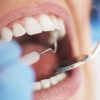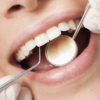
Restoring structural imperfections with Inlays & Onlays
Inlays and onlays are used to restore back teeth that have lost some of their structure due to trauma or decay. They are an alternative to dental crowns, and don’t cover the entire tooth. You might also hear inlays and onlays being referred to as indirect fillings, as unlike normal fillings, they require more than one visit to our dental office to be completed. An inlay or onlay is made at a dental laboratory before being bonded to your prepared tooth.An inlay is used to replace the chewing surface of the tooth, and is something we may recommend if you have lost a substantial amount of tooth structure in this area that cannot easily be replaced with a traditional filling. And onlay replaces not only the chewing surface, but also one or more of the cusps of the tooth. The tooth cusps are the raised ‘points’ that are located on the inner and outer edges of your back teeth.
Benefits of Inlays and Onlays
This type of restoration is precision made to fit your tooth preparation, and is used to help preserve as much healthy tooth material as possible. It is ideal for restoring teeth that have lost a moderate amount of material, and is a great alternative to having a dental crown as it will preserve the maximum amount of your natural tooth. Inlays and onlays can be made from a gold alloy, or they can be constructed from porcelain or composite resin.
The advantage of choosing a porcelain inlay or onlay is that it will not stain, and will blend in beautifully with your natural tooth colour. Gold alloy restorations are extremely hard wearing, and can be good for replacing areas that are subjected to particularly heavy biting forces. Inlays and onlays help to give strength to the remaining tooth structure so it will last longer. Once they are bonded onto your teeth then the precision fit ensures no bacteria can enter the tooth and that it is protected against further decay and infection.
The procedure for having an inlay or onlay is very similar to that required for a dental crown, and is usually completed in two visits to our dental office.
The first visit will be to prepare the damaged tooth and to take an impression of your mouth that is then sent to our dental laboratory so your inlay or onlay can be fabricated. You may be fitted with a temporary filling while your inlay or onlay is being made. Your permanent restoration can be fitted during your next visit, and provided we are happy with the margins and overall look, it’ll be bonded permanently in place. The final result is a stable and strong fully restored tooth that should last a long time.



